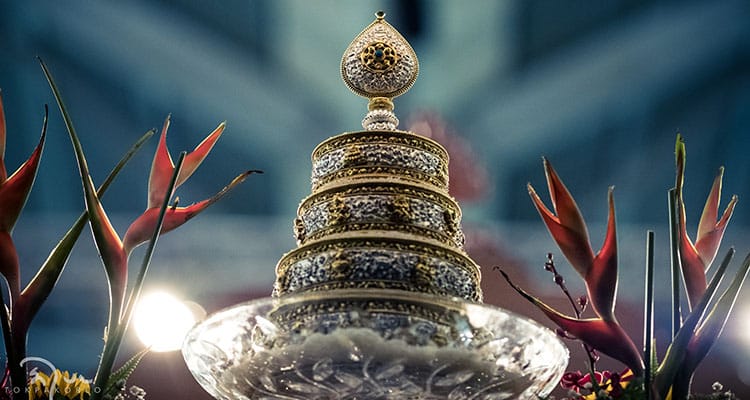The Buddhist Teaching on the Five Aggregates – Part 2
Category: Buddhist Path | Mind Trainer Articles | Popular

The Final Two Aggregates: Formation & Consciousness
This article is a continuation of this article on the first three aggregates – Form, Sensation & Perception.
The fourth skandha—samskara is the Sanskrit word for this—is more complex. It means conditions in a way, but it has a sense of making, of building. Sometimes samskara is translated as “formations” or “mental factors.” What is it? If you were trying to over-Westernize things and link this with Western or psychological ideas, you might say that formations are the unconscious processes. The sense is that we’ve not yet arrived at what, in Buddhism, is fully a moment of consciousness. We’re not there yet. So the formations are the things running just beneath the surface that are going to flavor the moment of consciousness when we perceive an object. They’re kind of flavorings, colorings, biases if you like, or they may be distortions depending on their emotional content. They are arising at all times, at every moment of consciousness, as are the first three skandhas: form, sensation, and perception. Actually, there’s a whole bunch of formations: in classical accounts you have fifty-one.
A little word about these numbers. Should we be obsessed with them? No, because they’re devices. All this stuff, all these lists, like I said earlier about the aggregates, are just ways of trying to look at the world attentively and discern its ever-shifting, ever-changing, kaleidoscopic, insubstantial nature. Talking about the five aggregates is just a tool. They’re not ultimately there, not ultimately true, including, of course, the skandha of formations. Then again, fifty-one is helpful because it teaches us to be attentive and to see how complex any moment of experience really is.
For instance, in the traditional accounts, within the fifty-one you have five ever-present formations, beginning of course with our old friend contact. Then sensations, then perceptions. They belong to the sub-category of the skandha of formations called “ever-present,” as do mental activity and the intention which moves us towards a given object.
And then there are influences, like being interested, being kind of curious, moving towards a certain type of object, or even mindfulness—that’s an influencer—and concentration, another influencer. And then there are the more emotional kind of influences or shapers, such as the eleven virtuous ones. Having confidence is one of these. For instance, when a Buddhist goes into a room and sees an image of the Buddha, because of their background that Buddha image will pass through their filter of faith. A non-Buddhist, maybe somebody who’s opposed to all religion, will see the same Buddha image and feel some kind of negativity or even hostility toward it. In fact, they end up seeing very different objects because the perception has passed through these kinds of filters: faith in the Buddhist mind and possibly hostility or maybe indifference in the non-Buddhist mind.
The virtuous associations, as we might call them, are built up through positive habits of choosing virtue over non-virtue. Nonviolence, patience, concern, and things like that are all in this category. Where do they come from? From the imprints of past experience. You see, the skandha of formations underlines that what arises in the mind is not accidental or random; it arises based on what we’ve cultivated through past actions, past thoughts, and past emotions. Our past experiences leave a kind of deposit, a kind of “shaper” of how we end up perceiving any particular encounter with the world and its inhabitants.
So there are eleven virtuous shapers. The bad news is there are also six root and twenty minor non-virtuous ones. There are obvious things you can think of like aggression, grasping, and the refusal to look at things properly that is ignorance. And then pride and doubt, along with the mistaken view of self-clinging—seeing everything through the prism of me, I, mine, which is the great narrower of our experience of the world. These are the six root non-virtues which can arise in any particular moment of experience.
The twenty secondary or associated non-virtuous factors are variations on the root ones. And then there are some which, depending on the context, can be good or bad. Like for instance, regret. Regret can be a non-helpful emotion if you regret something good that you’ve done. But if it’s a regret for something selfish that you’ve done, then it’s a good emotion to have.
At any given moment a whole bunch of these formations arise together, and they give the flavoring, the color, to the experience. I may think I am seeing an object freely, that it is what it is and I’m just a neutral observer of it, but in reality my experience is not neutral: the mental formations are the filters through which I see what I imagine to be out there, solid and independent.
Many ethical, religious, and Buddhist teachings focus on trying to work on ourselves at the level of the formations. For example, where there are bad habits of self-centeredness and disturbing emotions, we are encouraged to work on replacing them with good, virtuous habits.
Knowing about the fifty-one mental factors or types of association can be very helpful in that they help us examine what we are projecting onto any given experience. What am I bringing into world? Why am I screwing up spectacularly again and again in certain ways? Well, because I’ve got this certain set that I bring to everything. I didn’t realize it before, but now I can loosen it up if I’m willing to look into it, possibly by using the diagnostic tool of the fifty-one mental factors. Repeating these patterns is not inevitable.
Here again we see that what we thought was a solid, fixed thing is ever-changing. The associations that will influence one moment arise and pass with that experience. And then a whole other shaking up of the kaleidoscope might occur and another set of factors will come together. So again, it’s a way of seeing the diversity of our being. We contain multitudes, as Walt said.
And then, finally, the fifth skandha, is consciousness. It’s interesting that this is the fifth one even though we’ve been talking about mind for the preceding three skandhas. In Buddhist texts and Buddhist thought, “consciousness” means something very specific. It doesn’t mean mental experience alone because so much of mental experience is unconscious, as we’ve just seen with sensation, and even perceptions and formations.
Consciousness is the apprehender, the aggregate that discerns the object. And look how much has contributed to that moment, that act of discernment. The object I perceive is like the delivered object that has been created through the buildup of the aggregates. There’s the initial: do I experience this shape as pleasurable or displeasurable? Noticing or acknowledging that confirms that it’s either in one category or another. Add the mental associations brought up from the formations and it all delivers that final, completed moment of apprehension.
So in a way, the consciousness aggregate is simply the string that runs through these beads and makes the completed rosary. This is very important because we really want to think that consciousness is us. I’m the thinker, the one who’s perceiving the world. That’s the real me. But just look how contingent that is! It’s just the top soil, and most of the action, so to speak, has already happened in a subterranean way to shape the final moment of perceiving that beautiful, holy Buddha image, or that wonderful surfboard, or whatever it is. The experience of consciousness has been building through the aggregates and consciousness, in this sense, is the final apprehension of that built-up experience.
That’s why if you want to identify consciousness as your “self,” it’s really the worst bet of all because it’s so flimsy, so transient. So superficial, if you like. There’s just this last bit that comes and goes the flickers and is away again in a moment. And then another object arises and I experience it through all of those filters of the aggregates and I think I’m really seeing it. So consciousness is a really flimsy structure to build your house of self on. Then again, you’d also be foolish to build your house of self on the body, because let me tell you, I now know that the body’s constantly changing and decaying. It’s not autonomous, singular, or blissful, but in a crazy way it might make more sense to identify the self with the body than to put it onto the consciousness.
All the skandhas are contingent and unsolid, and consciousness most of all. There’s a lot more to say about this skandha, despite my describing it as flimsy and transient, a lot more we can look into. We can look into the abhidharma teachings as a whole as well. For now, let’s reflect on what we’ve learned about the five skandhas. Have fun searching for the self!








